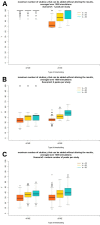Assessing robustness against potential publication bias in Activation Likelihood Estimation (ALE) meta-analyses for fMRI
- PMID: 30500854
- PMCID: PMC6267999
- DOI: 10.1371/journal.pone.0208177
Assessing robustness against potential publication bias in Activation Likelihood Estimation (ALE) meta-analyses for fMRI
Abstract
The importance of integrating research findings is incontrovertible and procedures for coordinate-based meta-analysis (CBMA) such as Activation Likelihood Estimation (ALE) have become a popular approach to combine results of fMRI studies when only peaks of activation are reported. As meta-analytical findings help building cumulative knowledge and guide future research, not only the quality of such analyses but also the way conclusions are drawn is extremely important. Like classical meta-analyses, coordinate-based meta-analyses can be subject to different forms of publication bias which may impact results and invalidate findings. The file drawer problem refers to the problem where studies fail to get published because they do not obtain anticipated results (e.g. due to lack of statistical significance). To enable assessing the stability of meta-analytical results and determine their robustness against the potential presence of the file drawer problem, we present an algorithm to determine the number of noise studies that can be added to an existing ALE fMRI meta-analysis before spatial convergence of reported activation peaks over studies in specific regions is no longer statistically significant. While methods to gain insight into the validity and limitations of results exist for other coordinate-based meta-analysis toolboxes, such as Galbraith plots for Multilevel Kernel Density Analysis (MKDA) and funnel plots and egger tests for seed-based d mapping, this procedure is the first to assess robustness against potential publication bias for the ALE algorithm. The method assists in interpreting meta-analytical results with the appropriate caution by looking how stable results remain in the presence of unreported information that may differ systematically from the information that is included. At the same time, the procedure provides further insight into the number of studies that drive the meta-analytical results. We illustrate the procedure through an example and test the effect of several parameters through extensive simulations. Code to generate noise studies is made freely available which enables users to easily use the algorithm when interpreting their results.
Conflict of interest statement
The authors have declared that no competing interests exist.
Figures







References
-
- Logothetis N. What we can do and what we cannot do with fmri. Nature. 2008;453: 869–878. 10.1038/nature06976 - DOI - PubMed
-
- Carp J. The secret lives of experiments: Methods reporting in the fmri literature. NeuroImage. 2012;63(1): 289–300. 10.1016/j.neuroimage.2012.07.004 - DOI - PubMed
-
- Durnez J, Moerkerke B, Nichols T. Post-hoc power estimation for topological inference in fmri. NeuroImage. 2014;84: 45–64. 10.1016/j.neuroimage.2013.07.072 - DOI - PubMed
-
- Sutton A, Jones D, Abrams K, Sheldon T, Song F. Methods for Meta-Analysis in Medical Research. John Wiley, London; 2000.
Publication types
MeSH terms
Grants and funding
LinkOut - more resources
Full Text Sources
Medical
Research Materials

